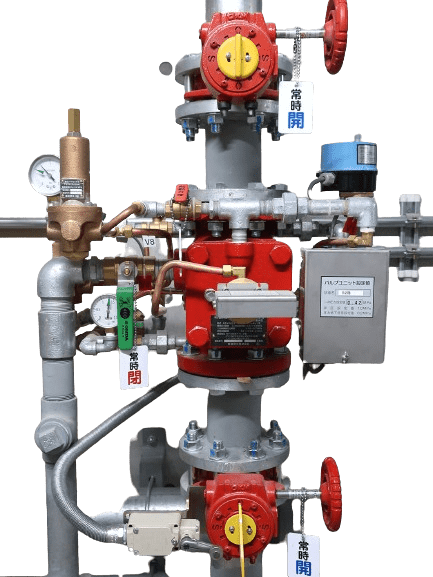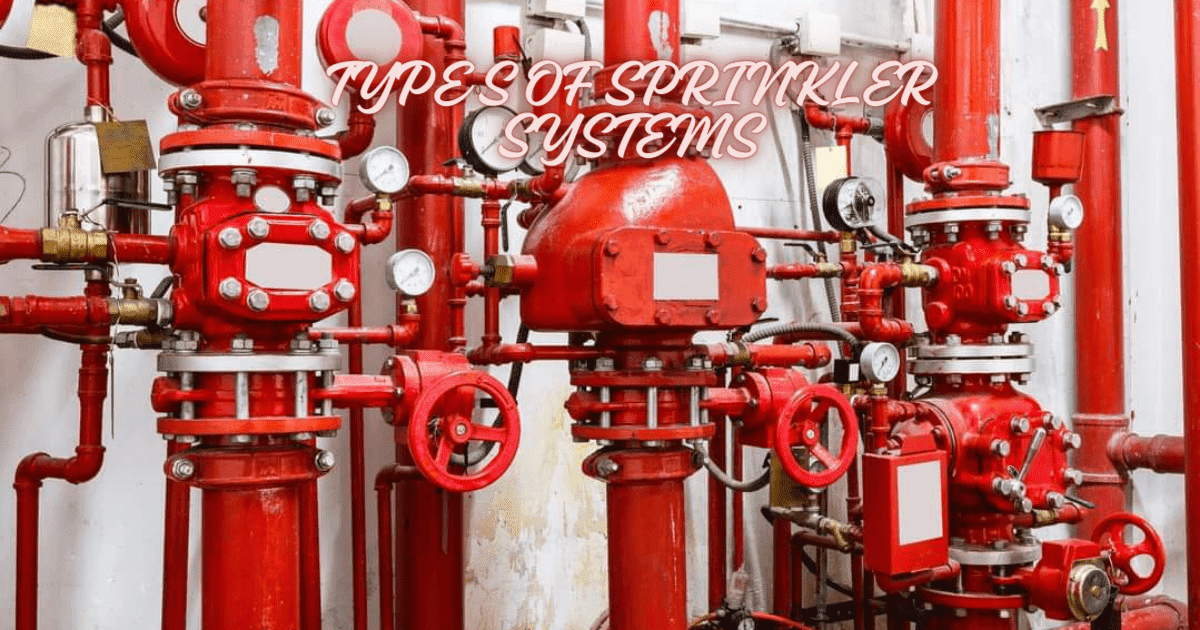Types of Sprinkler systems
There are several types of sprinkler systems that can be used depending on the requirement and availability. Here are some of the most common types of sprinkler systems:
1-Wet Pipe Sprinkler Systems:
The sprinkler piping in this kind of piping system is continuously filled with water. When the temperature at the ceiling rises, a sprinkler’s glass bulb or fusible link immediately breaks. It is typical to see the sprinkler head entirely filled with water, which prevents the water from freely flowing out of the system. One of the most dependable and economical types of sprinkler systems is the wet pipe sprinkler system.

2-Dry Pipe Sprinkler Systems:
Dry pipe systems don’t keep water in their pipes like wet pipe systems do. Rather, nitrogen or pressured air is pumped into them. The valve opens to let water flow through the pipes and out of the sprinkler heads when a fire is detected and the air pressure decreases.
3-Pre-Action Sprinkler Systems:
Pre-action sprinkler systems employ nitrogen or pressured air, just like dry pipe systems. They do, however, also contain a pre-action valve that needs to be turned on in order for water to move through the pipes. This kind of technology is perfect for places like data centers or museums where there is a need to reduce water damage.

read more-
4-Foam Water Sprinkler Systems:
In locations where flammable liquids are stored, foam water sprinkler systems are employed. In order to create a barrier between the fuel and the oxygen, foam is combined with water and sprayed onto the fire. Where water is insufficient to put out a fire, this kind of device is perfect

What is the difference between wet and dry pipe sprinkler systems?
Wet pipe sprinkler systems are filled with water continuously, whereas dry pipe sprinkler systems are filled with nitrogen or compressed air. This is the primary distinction between the two types of sprinkler systems. Water is constantly added to the sprinkler pipework in wet pipe systems. Water can flow through the pipes and out of the sprinkler heads as the temperature at the ceiling rises, automatically breaking the glass bulb or fusible link in a sprinkler. Conversely, dry pipe systems don’t have any water storage in their pipelines. Rather, nitrogen or pressured air is pumped into them. The valve opens to let water flow through the pipes and out of the sprinkler heads when a fire is detected and the air pressure decreases.
What are the advantages of dry-pipe sprinkler systems?
Dry pipe sprinkler systems have several advantages over wet pipe sprinkler systems. Firstly, dry pipe systems are less likely to freeze in cold temperatures, which can cause water to freeze inside a sprinkler pipe and burst it, potentially causing property damage and requiring costly cleanup. Secondly, dry pipe sprinkler systems are ideal for areas where water damage must be minimized, such as data centers or museums. Thirdly, dry pipe systems are less prone to leaks and corrosion than wet pipe systems, which can lead to obstructions and restrict pipe diameters, resulting in diminished system performance and extended water delivery times during a fire event. However, dry pipe systems are more expensive and time-consuming to install than wet pipe systems due to their added complexity and more stringent installation requirements. Additionally, dry pipe systems require more testing and maintenance than a traditional wet pipe system.
What are the disadvantages of dry-pipe sprinkler systems?
Dry pipe sprinkler systems have several disadvantages. Firstly, dry pipe systems are more expensive and time-consuming to install than wet pipe systems due to their added complexity and more stringent installation requirements. Secondly, dry pipe systems require more testing and maintenance than a traditional wet pipe system. Thirdly, dry pipe systems are less reliable than wet pipe systems due to the possibility of air leaks, which can cause the system to fail. Fourthly, dry pipe systems are more prone to corrosion than wet pipe systems, which can lead to obstructions and restrict pipe diameters, resulting in diminished system performance and extended water delivery times during a fire event. Finally, dry pipe systems are less effective than wet pipe systems in suppressing fires, as they take longer to activate and deliver water to the fire
What are the advantages of wet pipe sprinkler systems?
Wet pipe sprinkler systems have several advantages over other types of sprinkler systems. Firstly, wet pipe systems are highly reliable and require little maintenance. Secondly, wet pipe systems are the simplest and most cost-effective for most uses. Thirdly, wet pipe systems are ideal for areas where the temperature is above 40°F, as the pipes are always filled with water and can quickly extinguish a fire. Fourthly, wet pipe systems are less prone to leaks and corrosion than dry pipe systems, which can lead to obstructions and restrict pipe diameters, resulting in diminished system performance and extended water delivery times during a fire event. Finally, wet pipe systems are more effective than dry pipe systems in suppressing fires, as they activate faster and deliver water to the fire more quickly.
What are the disadvantages of wet pipe sprinkler systems?
Sprinkler systems with wet pipes have certain drawbacks. First of all, because the water in the pipes could freeze and harm the system, wet pipe systems shouldn’t be installed in subfreezing temperatures. Second, compared to dry pipe systems, wet pipe systems are more likely to leak and corrode. This can cause obstructions and restrict pipe diameters, which can lower system performance and cause longer water delivery times during a fire incident. Lastly, because wet pipe systems require more time to activate and provide water to the fire, they are less successful at suppressing fires than dry pipe systems.
How do I maintain my sprinkler system?
It’s crucial to maintain your sprinkler system so that it functions correctly when you need it most. Here are some pointers to keep your sprinkler system in good working order:
1. Clean your sprinkler heads.
Sprinkler heads may clog with dirt and other debris over time, which may affect how evenly the water is distributed around the lawn. To guarantee that your sprinkler heads are flowing water correctly and that the water pressure is constant, be sure to clean them once a year. To find out how to clean your sprinkler heads properly, speak with the manufacturer of your irrigation system.
2. Check for leaks:
Larger issues, like overwatering in one place and underwatering in another, can be caused by leaky sprinklers. Pay attention to the sprinkler system’s overall water flow. Verify that the water pressure is uniform and that the lawn isn’t unevenly moist or dry in any spots. As soon as you spot puddles on the nearby lawn or detect a leak in the sprinkler itself, take immediate action.
3-Check valves: The most common cause of sprinkler leaks is a malfunctioning valve. Through a device called a valve assembly or manifold, these plastic components assist in directing the water from its primary source to the remaining area of the yard. Make sure your valves are operating correctly by giving them a routine inspection
4. Test your system: To make sure your sprinkler system is operating correctly, test it frequently. This can be achieved by erecting empty tuna cans around your lawn and setting a timer for your sprinkler system to run. This will assist you in figuring out whether your sprinklers are watering your lawn with the appropriate quantity.
5. Listen to your lawn: You can learn a lot about the condition of your sprinkler system from your lawn. Your sprinkler system may require maintenance if you detect dry spots or areas that are not as green as the rest.
